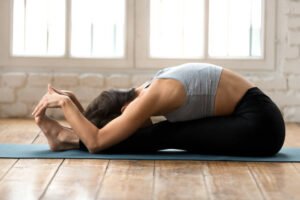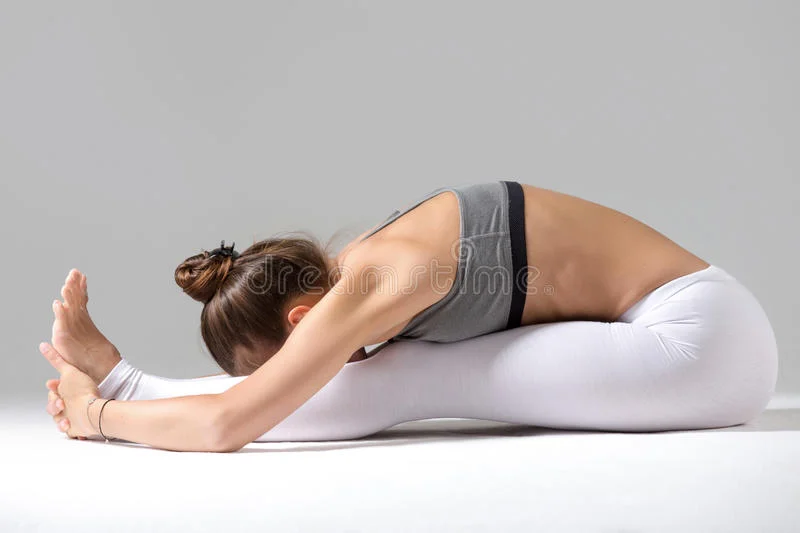Paschimottanasana Variations
 Paschimottanasana Variations is one of the most basic foundation poses in the paschimottanasana . It is most yoga enthusiasts breeze through practicing in one month. You have to try Paschimottanasana Variations when you learn to do Paschimottanasana. You will achieve more flexibility after doing this Paschimottanasana Variations.
Paschimottanasana Variations is one of the most basic foundation poses in the paschimottanasana . It is most yoga enthusiasts breeze through practicing in one month. You have to try Paschimottanasana Variations when you learn to do Paschimottanasana. You will achieve more flexibility after doing this Paschimottanasana Variations.Seated Forward Bend B – Paschimottanasana Variations B
The Seated Forward Bend B is a variation of the original pose. You may call it as Paschimottanasana B. This is a variation, in which you have to hold the soles of the feet. This creates intense tension in the calves, and you become more aware of your feet and knees. You need to develop a lot of core strength, on and above what was required for A. Additionally, you can do this asana or pose, only after you have loosened your hamstrings and lower back muscles. This asana is a creative way to loosen the back and leg muscles.Steps to Do Paschimottanasana Variations :
- You have to start the asana, by sitting on your buttocks, with your spine elongated and legs stretched in front of you. You can call it the staff pose or Dandasana.
- You have to rotate the shoulders a bit, while keeping your hands by the side of the hips, a little at the back. Breathe deeply, while sitting in this pose.
- You have to ensure to keep your thighs squeezed, so that the knees are flat, and the back of the legs at the knee area, firmly rests on the ground.
- You have to pull you belly in. After you are fixed in the same pose, you need to inhale and lift your hands up. Exhale and try to take your hands towards the feet.
- Subsequently, inhale and lift your head to look upwards, then exhale again and try to hold the outer edges of the feet or the sole. Now, pull your torso forward, with the help of your hands and feet engagement.
- Inhale and try to elongate the spine and then exhale and fold your torso forward. You have to stay in this position for 5/6 breaths.
- You can close your eyes or keep them open, and practice mindful breathing. With every exhalation, you have to lift the torso and propel slightly forward.
- Ensure that you fold forward from the back of the pelvic region, so that there is no hump. You have to keep the neck muscles normally, without strain and the head held passively.
- When it is time to release, you have to inhale, look upwards and then exhale, and bring the torso upwards from the pelvic region.
- Slowly, allow your hands to rest by the sides of the hips, as in the original position.
- Relax and sit in Staff pose or Dandasana pose.
Seated Forward Bend C – Paschimottanasana Variations C
In the Seated Forward Bend C – Paschimottanasana C, you have to grab the wrist of one hand, with the palm of the other, beyond the feet. The three categories of asanas A, B and C are in their increased order of difficulty.Steps to Do Paschimottanasana Variations :
- You have to start the asana, like Paschimottanasana pose A and B, by sitting on your buttocks, with your spine elongated and legs stretched in front of you.
- Rotate the shoulders, while keeping your hands by the side of the hips, a little at the back. Breathe deeply, while sitting in this pose.
- Keep the thighs squeezed, so that the knees are flat, and the back of the legs at the knee area, firmly rests on the ground. Do not let the knees move up.
- You have to pull you belly in. After you are fixed in the same pose, you need to inhale and lift your hands up. Exhale and try to take your hands towards the feet.
- Subsequently, inhale and lift your head to look upwards, then exhale again and try to hold the wrist of one hand with the palm of the other, from the outer side of the feet. Now, pull your torso forward.
- Inhale and try to elongate the spine and then exhale and fold your torso forward. You have to stay in this position for 5/6 breaths.
- You can close your eyes and practice mindful breathing or keep the eyes open. With every exhalation, you have to lift the torso, elongate the spine, and propel slightly forward.
- You have to keep the neck muscles unstressed, and the head held without tension.
- Release in the same manner as poses A and B.
- Slowly, allow your hands to rest by the sides of the hips, as in the original position.
- Relax and sit in Staff pose or Dandasana pose.

Deepen Your Yoga Practice with Hari Om Yoga Vidya School
Located in the heart of Rishikesh, Hari Om Yoga Vidya School is a place where ancient yogic wisdom meets modern teaching techniques. As a top yoga school in Rishikesh, we are committed to providing authentic, immersive yoga education in a peaceful, spiritual setting. Recognized as one of the best yoga schools in Rishikesh, we offer structured training programs designed to help you evolve in your practice, whether you are a beginner or an experienced yogi.
If you’re searching for a yoga school in Rishikesh that focuses on holistic learning, experienced teachers, and a supportive community, look no further!
Explore Our Yoga Teacher Training & Retreats
At Hari Om Yoga Vidya School, we offer a range of courses tailored for different levels of practitioners:
✅ 100-Hour Yoga Teacher Training in Rishikesh – A foundational course for those looking to begin their yoga journey.
✅ 200-Hour Yoga Teacher Training in Rishikesh – An internationally recognized certification for aspiring yoga teachers.
✅ 300-Hour Yoga Teacher Training in Rishikesh – Advanced training to deepen your practice and refine your teaching skills.
✅ 7-Day Yoga Retreat in Rishikesh – A rejuvenating escape into yoga, meditation, and self-discovery.
✅ 10-Day Yoga Retreats in Rishikesh – A transformative experience that blends yoga, relaxation, and Himalayan serenity.
Join us for a life-changing experience and become part of our global yoga family! 🌿✨



